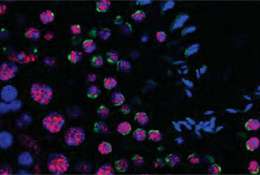A brighter future for infertility treatment: study

(Medical Xpress) -- Male infertility could soon have a boost through new treatments at a sub-DNA 'epigenetic' level, according to researchers from The Australian National University.
The research team, led by Professor David Tremethick of The John Curtin School of Medical Research at ANU, have uncovered a new mechanism of gene activation which will have important implications in understanding how cellular differentiation is achieved. In the future, it may also allow the development of new approaches to treat male infertility. Their research is published in the latest issue of Nature Structural and Molecular Biology.
The team which included post-doctoral researchers Tanya Soboleva and Maxim Nekrasov made the breakthrough by looking at what’s happening in our bodies at the epigenetic level, which controls how our DNA is expressed.
“Epigenetic information goes beyond DNA-stored information essential for interpreting our genome,” said Professor Tremethick. “There are over 250 different cell types in the human body, and while the DNA sequence of these is essentially the same, their epigenetic information or profiles are very different. Additionally, our entire DNA is compacted into a structure known as chromatin.
“Epigenetic information controls gene expression, ensuring that only genes for a specific cell type are turned on, while inappropriate genes are switched off by ‘opening’ or ‘closing’ the structure of chromatin.
“Regulation of this epigenetic information significantly contributes to embryonic development, and ensures our capacity to reproduce. Mis-regulation of our epigenetic code has been directly implicated in many common human diseases, as well as contributing to human infertility,” he said.
The research team’s study characterized the epigenetic changes that occur during sperm development, and in doing so identified a novel epigenetic mark, called H2A.Lap1.
“Our research revealed that H2A.Lap1 regulates sperm gene expression by directly opening the chromatin structure at the start site of active genes,” said Professor Tremethick.
“The study has therefore uncovered a new way to activate genes, which could help us understand how cellular differentiation is achieved. In the future, this could also allow for the development of treatments for male infertility which operate at the epigenetic level.”


















